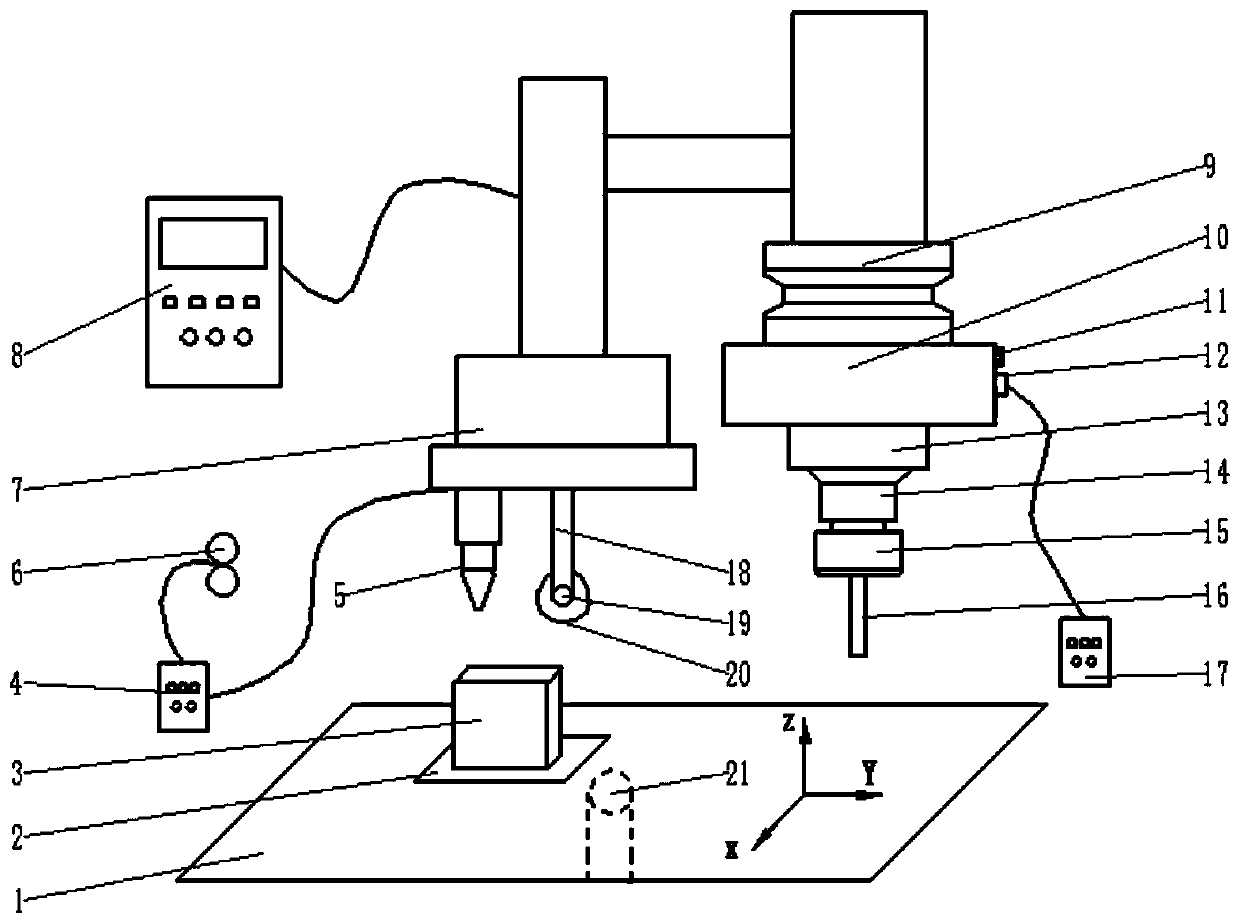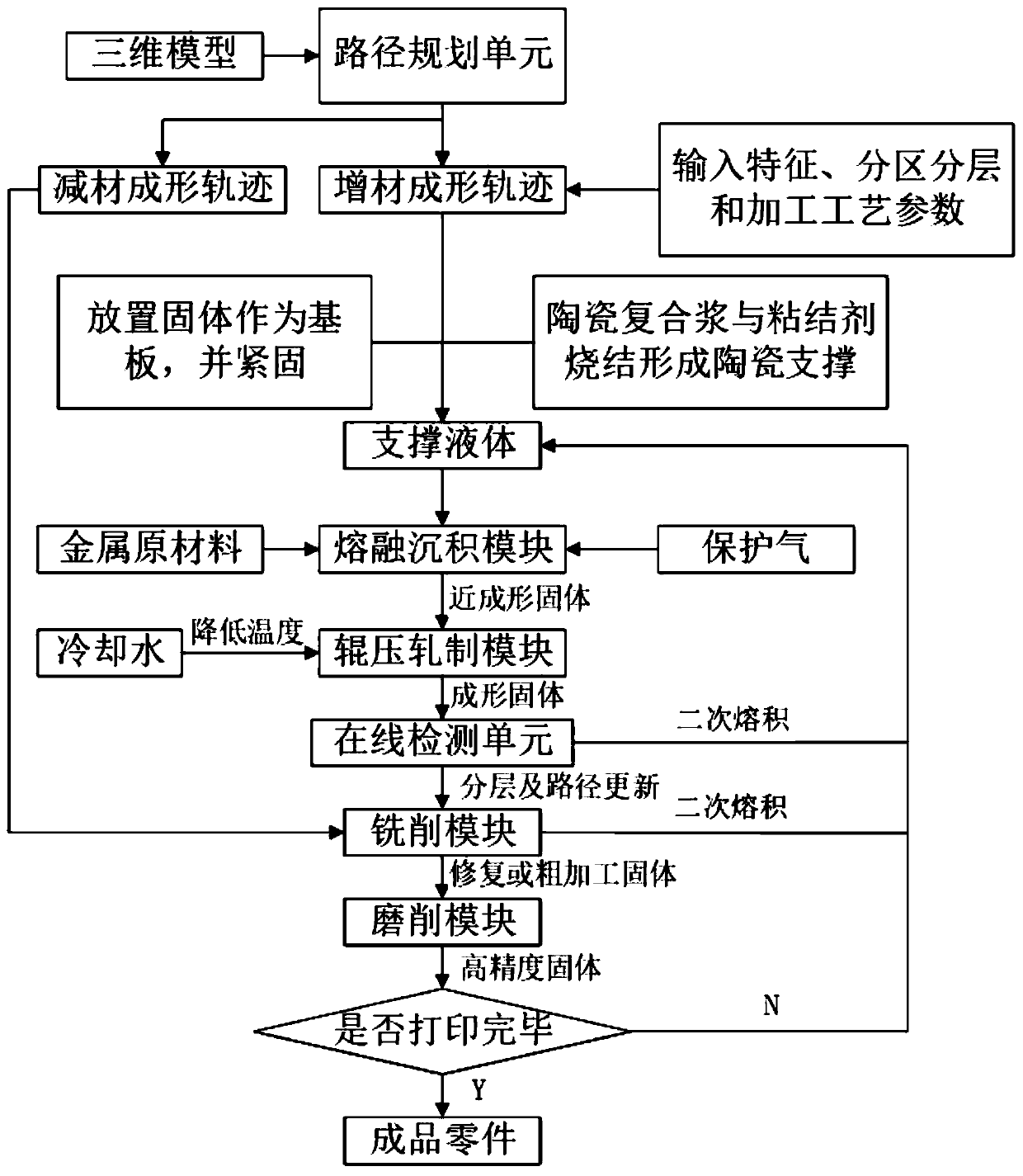Metal part manufacturing system and method adopting micro-casting-forging and milling-grinding in-situ composite
An in-situ composite technology for metal parts, applied in the field of metal parts manufacturing, can solve problems such as poor surface quality, uneven structure, large residual stress, etc., and achieve good processing quality, reduce residual stress, and small ultrasonic cutting force.
- Summary
- Abstract
- Description
- Claims
- Application Information
AI Technical Summary
Problems solved by technology
Method used
Image
Examples
Embodiment 1
[0051] use as figure 1 In the system shown, the selected raw material is titanium alloy TC4-DT, the shape of the raw material is metal wire, and the supply method is wire-feeding, which specifically includes the following steps:
[0052] S1 generates the subtractive forming trajectory and additive forming trajectory suitable for the part structure through the 3D CAD model and features, partitioning and layering, and processing parameters of the metal part to be formed;
[0053] S2 Thoroughly clean the substrate and metal wire to remove moisture, impurities and oxide film, so that the entire manufacturing space is sealed by the atmosphere chamber and filled with helium-argon mixed gas to prevent the molten metal from being oxidized;
[0054] The heat source type of S3 melting heat source is arc heat source, Fronius welding power source CMT Advanced 4000 is used, and the matching wire feeding mechanism VR 7000 CMT is selected as the feeding mechanism to melt the metal wire, and ...
Embodiment 2
[0059] use as figure 1 In the system shown, the selected raw material is titanium alloy TC4-DT, the shape of the raw material is metal wire, and the supply method is wire-feeding, which specifically includes the following steps:
[0060] S1 to S5 are identical with embodiment 1;
[0061] The S6 grinding tool adopts the grinding wheel, which replaces the milling cutter with the grinding wheel, and grinds the surface of the formed part whose defect and shape meet the manufacturing standard after milling, so as to improve the surface accuracy of the part;
[0062] S7 repeats S3 to S6 until the processing and manufacturing of the entire metal part is completed.
Embodiment 3
[0064] use as figure 2 In the system shown, the selected raw material is titanium alloy TC4, the shape of the raw material is metal wire, and the supply method is wire-feeding, which specifically includes the following steps:
[0065] S1 generates the subtractive forming trajectory and additive forming trajectory suitable for the part structure through the 3D CAD model and features, partitioning and layering, and processing parameters of the metal part to be formed;
[0066] S2 Thoroughly clean the substrate and metal wire to remove moisture, impurities and oxide film, so that the entire manufacturing space is sealed by the atmosphere chamber and filled with helium-argon mixed gas to prevent the molten metal from being oxidized;
[0067]The heat source type of S3 melting heat source is arc heat source, Fronius welding power supply CMT Advanced 4000 is used, and the matching wire feeding mechanism VR 7000 CMT is selected as the feeding mechanism to melt the metal wire, and the...
PUM
 Login to View More
Login to View More Abstract
Description
Claims
Application Information
 Login to View More
Login to View More - R&D
- Intellectual Property
- Life Sciences
- Materials
- Tech Scout
- Unparalleled Data Quality
- Higher Quality Content
- 60% Fewer Hallucinations
Browse by: Latest US Patents, China's latest patents, Technical Efficacy Thesaurus, Application Domain, Technology Topic, Popular Technical Reports.
© 2025 PatSnap. All rights reserved.Legal|Privacy policy|Modern Slavery Act Transparency Statement|Sitemap|About US| Contact US: help@patsnap.com



